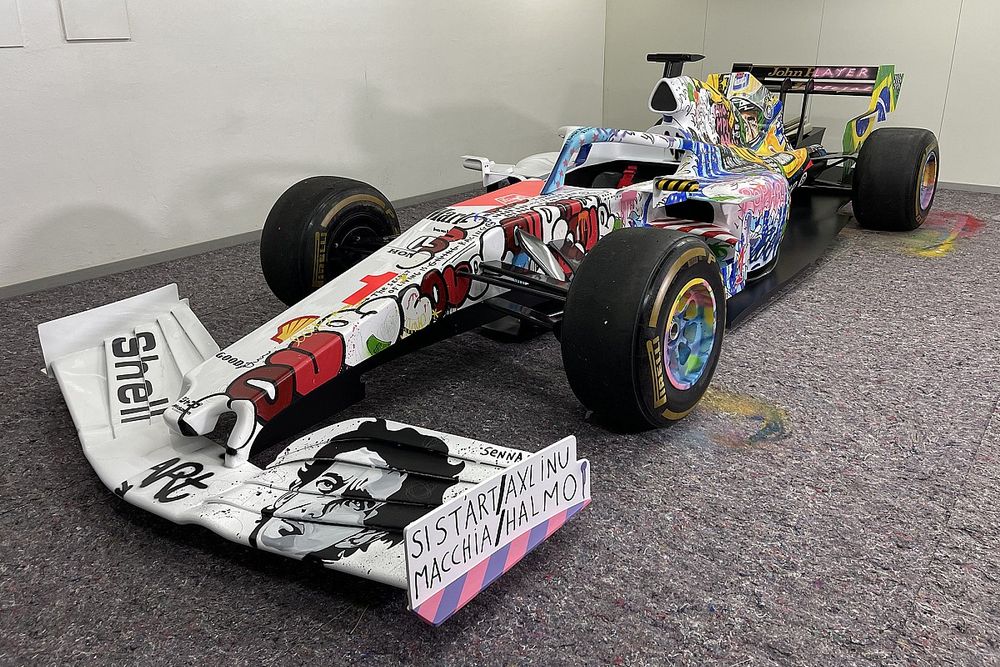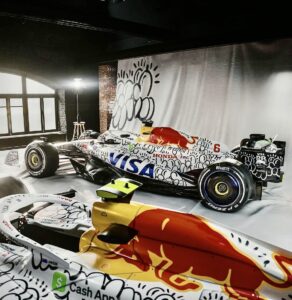The roar of engines reverberating through the rolling English countryside. The scent of petrol and rain-soaked tarmac. The sight of Union Jacks fluttering amidst a sea of devoted fans. This is the British Grand Prix — a festival as much as a race, a symbol of motorsport’s long, storied romance with the UK. In 2025, however, that narrative has gained a bold new stroke of color: Slawn, the Nigerian-British artist known for his raw, exuberant street aesthetic, has painted the first-ever Formula One art car to compete at Silverstone.
For purists, Formula One is sacred — an interplay of precision, speed, and aerodynamics. For artists, however, a Formula One car is more than a machine; it is a moving sculpture, an exquisite platform upon which new stories can be told. This year, these two worlds have collided spectacularly, resulting in a car that is as much a rolling gallery piece as it is a race-winning machine.
The Artist Behind the Helmet: Who is Slawn?
Born in Lagos, Nigeria, and now a fixture in London’s contemporary art scene, Adebayo Olayanju — known to the world simply as Slawn — represents a new generation of young Black artists reshaping the global visual language. His style is deeply influenced by graffiti, skate culture, and the frenetic energy of London’s streets. Slawn’s meteoric rise began with his cheeky, playful interpretations of cultural icons, but his work transcends pure street art. Each piece is layered with personal narrative, often referencing his upbringing, diasporic identity, and the raw honesty of everyday life.
Slawn’s foray into larger, public canvases — murals, collaborations with fashion brands, and now motorsport — shows a creative mind in constant motion. By placing his design on an F1 car, Slawn redefines what it means to merge art with performance. The idea of painting a machine designed for ultimate function speaks to the tension between chaos and control — a motif that echoes throughout his work.
Art and Speed: An Unexpected Convergence
The idea of an “art car” is not entirely new. BMW famously began its Art Car project in 1975, inviting artists like Andy Warhol, Roy Lichtenstein, and Jeff Koons to transform their race cars into moving artworks. Yet these were primarily designed for exhibitions or special events, not necessarily for the brutal demands of Formula One racing.
Formula One, with its multi-billion-dollar engineering, has historically been cautious about any visual experimentation that might disrupt aerodynamics or branding. Liveries are optimized for sponsor visibility, and every square inch is calculated to perfection. Enter Slawn: an artist unafraid to challenge these conventions. His graffiti-like brushwork, wild color splashes, and frenetic patterns break from the traditionally sleek, corporate lines of F1 design.
The Slawn art car has achieved something revolutionary: not just decoration but defiance. It moves beyond simple brand storytelling to become an emblem of artistic freedom in one of the world’s most conservative sporting environments.
British GP: A Fitting Debut
Silverstone, the spiritual home of British motorsport, was a carefully chosen debut venue. The British Grand Prix is synonymous with heritage, from its role as the first Formula One World Championship race in 1950 to its reputation as a driver’s favorite for its sweeping corners and passionate crowds. By introducing an art car here, organizers and sponsors are signaling a future where motorsport is not only about engineering prowess but also about cultural and aesthetic statements.
For Slawn, racing at Silverstone carries personal resonance. The track represents a collision point of British identity, legacy, and spectacle — all themes deeply embedded in his art. Watching his creation tear down Hangar Straight at over 200 mph, one feels a visceral thrill akin to seeing a mural come alive, animated by thunderous horsepower.
Technical Challenges and Creative Triumphs
Painting an F1 car is far more complex than working on a canvas or even a wall. The bodywork is carbon fiber, sculpted for aerodynamic perfection. Every added layer of paint, every millimeter of thickness, is scrutinized for weight and airflow disruption. Slawn worked closely with engineers and aerodynamicists, balancing his expressive style with technical imperatives.
Unlike traditional paint jobs, this livery integrates advanced materials, including specialized light-reflecting pigments and nano-coatings to withstand extreme temperatures and friction. The collaboration also demanded digital modeling, allowing Slawn to simulate how his design would appear at different angles and speeds. The result is a dynamic livery that seems to shift and morph as the car races through the circuit — a living artwork.
A Cultural Moment in Motorsport
This isn’t just a livery change; it’s a cultural moment. The British Grand Prix, often characterized by its conservative traditions, is now host to a radical gesture of inclusivity and creative daring. Slawn’s involvement brings new audiences to Formula One — young art fans, urban creatives, and communities previously unengaged with motorsport. It marks a broader shift toward making F1 more accessible and culturally resonant.
It’s also an important moment for the artist himself. Slawn has consistently advocated for broader representation within the arts and public life. His foray into F1 embodies that ethos, breaking barriers not only for Black artists but for a new generation of creators who see no divide between street art, fashion, and high-performance engineering.
Echoes in Art and Fashion
The Slawn F1 art car resonates beyond the track. Much like how artists have collaborated with fashion brands — think Takashi Murakami with Louis Vuitton or KAWS with Dior — this move symbolizes the merging of creative disciplines. Art cars become wearable art’s mechanical cousin, an emblem of movement and transformation.
In the last few years, we’ve seen an explosion of cross-disciplinary collaborations. Virgil Abloh’s reimagining of Mercedes-Benz vehicles, Daniel Arsham’s work with Porsche, and even Jaden Smith’s custom Tesla — all point to a hunger for vehicles that tell stories beyond horsepower and speed. Slawn’s work is a bold chapter in this evolving narrative.
Public Reaction and Media Buzz
As expected, social media exploded when the Slawn art car was unveiled in Silverstone’s paddock. Fans praised the design as a breath of fresh air, a defiance of F1’s sometimes sterile aesthetic. Critics, meanwhile, debated its impact on tradition, arguing whether art should enter the strictly regulated world of professional racing.
Regardless of opinion, the car did exactly what it set out to do: provoke discussion, ignite passion, and expand the cultural footprint of Formula One. For many, seeing Slawn’s expressive lines flash by on live broadcast felt like witnessing history — a race and an artwork unfolding in real time.
What’s Next?
The success of this project has already sparked speculation. Will other artists follow suit? Could we see a series of rotating artist collaborations each season? Might other race series adopt similar initiatives?
If this becomes a trend, it could fundamentally change motorsport aesthetics, turning race weekends into moving art exhibitions. Imagine a grid where each car is a unique piece, representing diverse global artists, cultures, and messages. Such a shift would be as revolutionary as hybrid engines or ground-effect aerodynamics.
Impression
Slawn’s F1 art car is more than a painted machine — it is a manifesto. It challenges old notions of what belongs on the racetrack and who gets to shape its visual narrative. It suggests that speed and soul are not mutually exclusive, that adrenaline and art can share the same line on the asphalt.
This project embodies a rare convergence of worlds: the grit of the streets, the glamour of Formula One, and the transcendent language of contemporary art. It symbolizes a future where sport is not only about competition but also about community, storytelling, and inclusivity.
As the British Grand Prix roars on, with the Slawn car weaving through the legendary corners of Silverstone, spectators aren’t just watching a race. They’re witnessing a canvas in motion — a bright, fearless expression of identity, heritage, and audacious creativity at 200 miles per hour.
No comments yet.









